Hikers and spaniels brave the weather - today's snow in picturespublished at 12:50 GMT
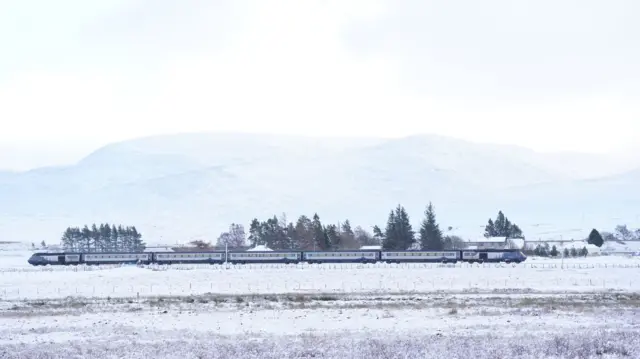 Image source, PA Media
Image source, PA MediaDalwhinnie, Scottish Highlands

Pen-y-Pass, Snowdonia
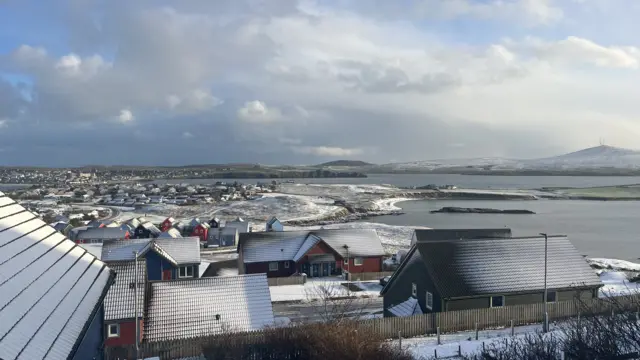
Shetland Islands
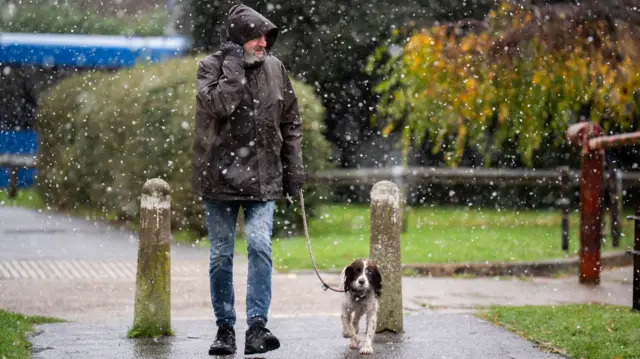 Image source, PA Media
Image source, PA MediaCrawley, West Sussex
Snow is blanketing parts of the UK as a cold snap brings freezing conditions and possible travel disruption - here's the forecast for the rest of the day
The Met Office issues new yellow warnings for snow and ice for parts of England and all of Northern Ireland, with an amber warning to take effect in north-east England on Thursday
Dozens of schools are closed in northern parts of Scotland, while there are widespread icy patches across much of Wales
Cold weather tips: Here's how to keep your home warm, drive safely, and look after your pets
What's the weather like where you are? Send us your updates, pictures and questions on WhatsApp: +44 7756 165803, external
Watch weather cameras across the UK live at the top of the page
Watch: The latest weather forecast as cold snap hits UK
Edited by Alex Smith and Tinshui Yeung
 Image source, PA Media
Image source, PA MediaDalwhinnie, Scottish Highlands

Pen-y-Pass, Snowdonia

Shetland Islands
 Image source, PA Media
Image source, PA MediaCrawley, West Sussex
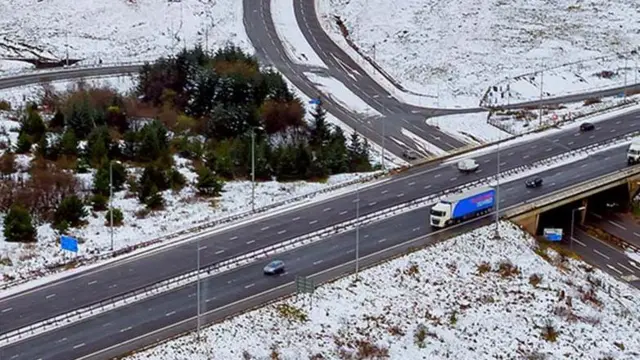 Image source, NATIONAL HIGHWAYS
Image source, NATIONAL HIGHWAYSWoodhead Pass, a major road connecting Greater Manchester and South Yorkshire, has reopened after overnight snowfall closed it to traffic.
National Highways said the A628 was closed in both directions between the A616 for Hollingworth and the A57 for Flouch, as several heavy goods vehicles were struggling in the wintry conditions and needed assistance.
"Road users are also advised to allow extra time for their journey," National Highways said.
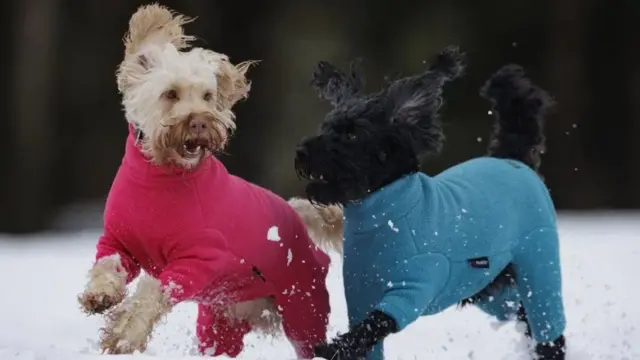 Image source, PA Media
Image source, PA MediaLike humans, animals can be at risk of hypothermia if they become too cold.
Dogs still need walks during cold weather. Usually their fur will keep them warm, but be cautious when letting dogs off the lead in the snow, and supervise them closely as hazards may be hidden.
The PDSA charity recommends moving smaller pets - such as rabbits, guinea pigs and ferrets - inside if they live in outdoor hutches. Extra playtime can make sure pets keep active. Indoor toys can help.
During the day, experts say cats who are used to going outside should continue to do so.
But the PDSA advises making sure they can easily get back inside through a cat flap whenever they want, or have a warm outside shelter they can go. Providing litter trays inside is recommended, so they have a warm toileting option.
Chickens and hens are incredibly resilient and should typically cope well with a bit of cold weather, according to the British Hen Welfare Trust. Make sure to insulate hen houses, and regularly check that their water supplies have not frozen.
As cold weather sees parts of the country hit with snow, sleet and ice, we're streaming some live weather cameras from across the UK.
You can follow along by clicking watch live at the top of the page.
You've been sending us your pictures of the wintry weather today - here's some we've received from Guildford and Luton.
As a reminder, you can send us your updates, pictures and questions on WhatsApp: +44 7756 165803, external
 Image source, Phil Layton
Image source, Phil LaytonNewlands Corner, Guildford
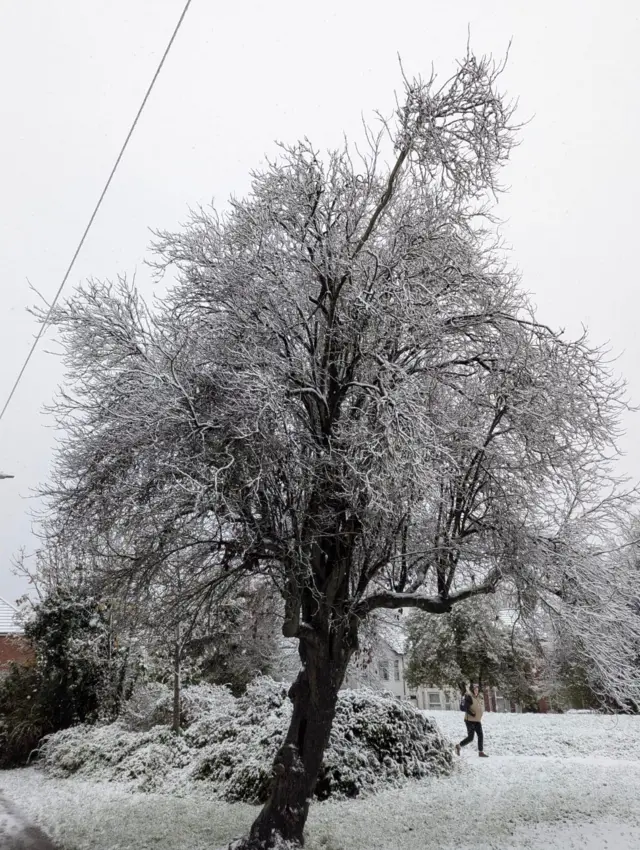 Image source, Sarah Bailey
Image source, Sarah BaileyLuton
 Helen Willetts
Helen Willetts
Lead weather presenter

Sleet and snow showers will continue across Scotland, Northern Ireland, western Wales, south-west England and eastern England - which means further problems for travel, not only with snow but ice too.
Elsewhere, the early rain and snow mix will clear and the sun will come out, but it will be a bitter day with top temperatures well below November averages - between 7-11C.
That’s something we've not seen so far this autumn.
This evening and overnight, there will be little change in the weather with wintry showers continuing to drape themselves around the UK's coastal counties, moving inland on the strong wind.
It will soon turn frosty, with very few places likely to escape. Following the earlier wintry mix it means ice will become a major hazard for many.
Remember, the Met Office amber warning for north-east England kicks in at 03:00 GMT on Thursday morning, where as much as 25cm of snow is expected to build up from now until the end of the day tomorrow.
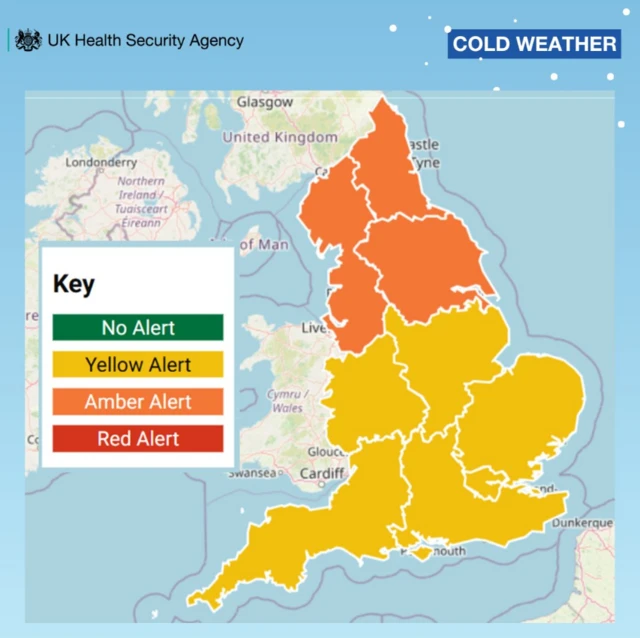 Image source, UKHSA
Image source, UKHSAAs well as a number of Met Office weather warnings, the UK Health Security Agency (UKHSA) has issued cold-health alerts for England.
An amber alert came into effect on Monday and is due to last until Saturday morning for Yorkshire and Humber, and the north-west and north-east regions.
The rest of England will be under a yellow alert during the same period.
The UKHSA's head of extreme events and health protection, Agostinho Sousa, says it is "vital to check in on friends, family and neighbours that are most vulnerable".
"The forecasted temperatures can have a serious impact on the health of some people, leading to increased risk of heart attacks, strokes and chest infections, particularly for individuals over the age of 65 and those with pre-existing health conditions," he says.

Jess Warren
BBC London
London's severe weather emergency protocol (SWEP) has been activated, instigating emergency accommodation for people sleeping rough.
The plan - which is actioned when temperatures fall to 0C - sees boroughs across the capital, alongside homelessness charities, open additional emergency accommodation for people sleeping rough in conditions that could pose a threat to life.
More than 13,000 people were seen rough sleeping by outreach workers in London in 2024/25 - the highest number ever recorded on London's homelessness database.
Mayor of London, Sadiq Khan says the SWEP would ensure anyone sleeping rough was offered emergency accommodation and support to stay off the streets.
In the cold weather, it can be hard to stay warm and keep your energy bill down.
Making your home more energy efficient can be costly and may not be possible if you're renting, but there are some cheap solutions to try to save money.
Plugging gaps in your doors can stop heat from escaping. By simply adding a draught excluder - or even a rolled up towel - you can stop hot air from escaping.
You can make your own draught excluder with an old pair of jeans and a few basic sewing items - with some more detailed instructions here.
It's also worth getting some heavy curtains to help keep the heat in the room, if you don't have double-glazed windows, according to the Energy Saving Trust.

The Met Office has issued new weather warnings affecting parts of England and Northern Ireland.
A new yellow snow and ice warning has been issued for all of Northern Ireland - in place from 17:00 GMT today until 12:00 tomorrow. The initial yellow snow and ice warning warning is due to end at lunchtime today.
A new yellow snow and ice warning has been issued for parts of East Anglia, beginning from 17:00 today until 11:00 tomorrow.
And an amber snow warning for tomorrow has been updated for parts of north-east England, largely covering the North York Moors. The start time has been brought forward from 05:00 to 03:00 tomorrow morning, and it is still due to end at 21:00.
 Ken Banks
Ken Banks
North-east Scotland reporter, in Aberdeen
Dozens of schools have been closed and travel warnings are in place after snow swept across northern parts of Scotland.
Fifteen schools in Aberdeenshire and 20 in the Highland Council area are shut for the day. Several schools and nurseries in Shetland and three in Moray are also closed.
Drivers also face difficult road conditions, with the A9 at Dunbeath in Caithness closed earlier due to a jack-knifed lorry. A car was also photographed crashed into a bollard and lamppost in Aberdeen.
A yellow warning for snow and ice in the north of the country remains in place until Thursday night.
 Image source, BBC/Ken Banks
Image source, BBC/Ken Banks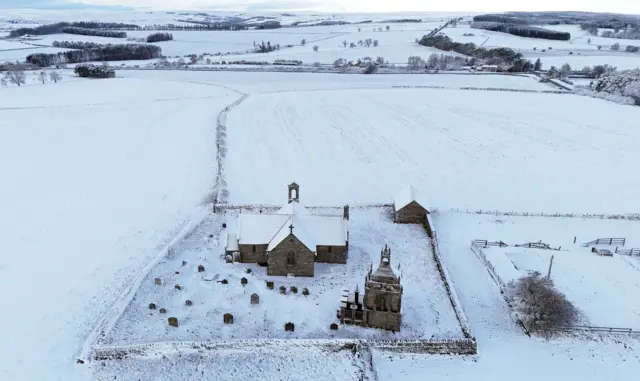 Image source, PA Media
Image source, PA MediaKiln Pit Hill, Northumberland
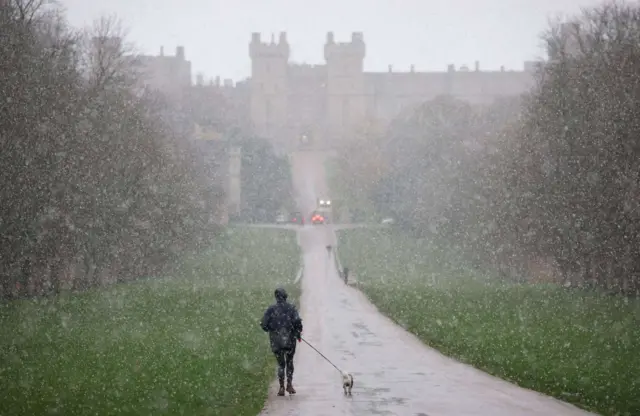 Image source, Reuters
Image source, ReutersWindsor Castle, Windsor
 Image source, PA Media
Image source, PA MediaNewtonmore, Highland
 Image source, PA Media
Image source, PA MediaTow Law, County Durham
Jennifer Clarke
BBC News

Driving in severe winter weather can be difficult, and in very bad conditions you should avoid driving at all unless your journey is absolutely essential.
But if you do need to use your car in snowy or icy conditions, careful preparations can help.
Wear warm clothes and comfortable shoes. Pack a waterproof coat, hat, gloves, sturdy boots and a blanket to keep you warm in case you do get stuck or have to leave your car. You may also need sunglasses in bright weather.
Make sure you have a fully charged mobile, a torch and batteries, and any medication you need.
Carry a shovel to clear snow and some old bits of carpet, or cat litter, to put under the tyres if you get stuck.
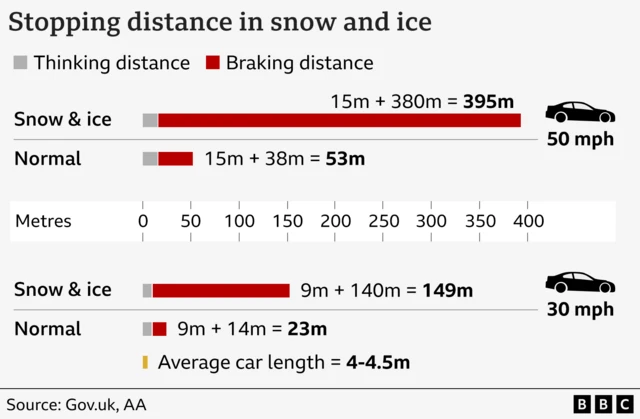
Consider buying winter tyres, which offer extra grip, especially if you live in an area which regularly experiences snow.
Car batteries run down more quickly in winter. Take regular long journeys to keep yours running well, or consider using a trickle-charger, which is designed to stop your battery going flat.
 Image source, Owen Humphreys/PA Wire
Image source, Owen Humphreys/PA WireTow Law, in County Durham, is under a yellow weather warning this morning
National Highways - which is responsible for operating and maintaining major roads in England - says its winter operation is now "in full swing".
Darren Clark, the organisation's severe weather resilience adviser, says snowy forecasts and freezing conditions across England means gritters are "already completing their first runs of the season".
He says: "We work closely with the Met Office, receiving updated forecasts throughout the day and our crews are on duty around the clock, ready to head out whenever they're needed."
Clark also urged drivers to "not be caught out" by winter weather - making sure to top up on fuel, screen wash, and perform quick checks on lights and tires.
"Quick checks...and planning ahead, can make all the difference when the weather turns."
 Simon King
Simon King
Presenter and meteorologist, BBC Weather
Air temperature needs to be below +2C for it to snow.
Some of our biggest snowflakes occur when the temperature is between 0 and +2 because snowflakes can stick together when they are slightly melted.
This leads to what we would call ‘wet snow’, the best type for making snowballs.
Drier, more powdery snow will occur when the temperature is generally a few degrees below freezing.
Sometimes it can be too cold to snow, not because of the actual temperature but because the colder the air, the drier it is with no moisture for snow to form.
We've been receiving pictures of the wintry conditions from you via the BBC's Weather Watchers.
We'll be posting more throughout the day - please do keep them coming:
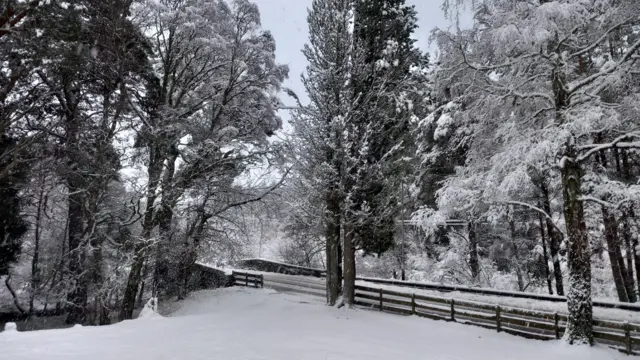 Image source, Speygirl
Image source, SpeygirlNethy Bridge, Highland
 Image source, gemtelf
Image source, gemtelfRothley, Northumberland
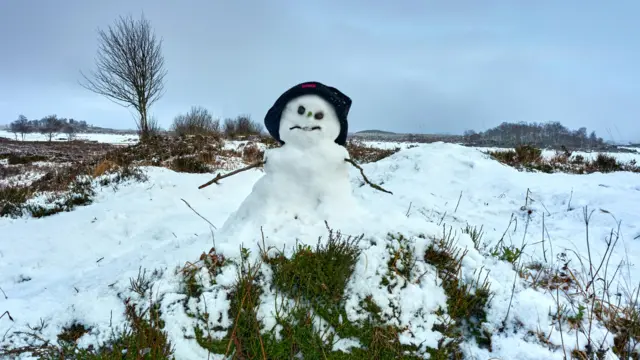 Image source, Mr C
Image source, Mr CGlencoe, Highland
 Image source, Poppa J
Image source, Poppa JFour Marks, Hampshire
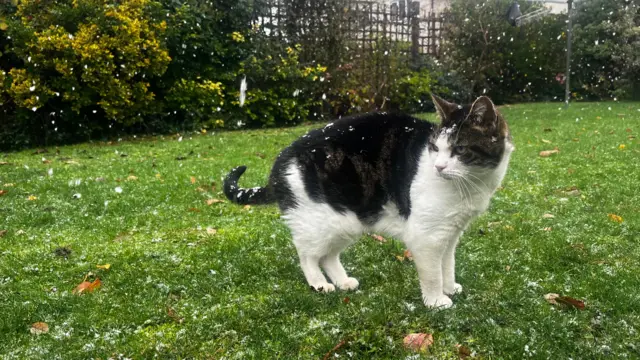 Image source, Laura B
Image source, Laura BEwell, Surrey
 Image source, Mightyship
Image source, MightyshipBucknell, Shropshire
The Met Office currently has a number of weather warnings in place across the UK.
There are yellow warnings for snow and ice in:
A yellow warning for snow and ice will also be in place from 12:00 GMT - in Cornwall, Devon, Plymouth, Carmarthenshire, Ceredigion, Pembrokeshire, Swansea.
Meanwhile there are yellow warnings for ice in:
Weather warnings are issued by the Met Office and are given a colour – yellow, amber, or red – depending on their impact and likelihood.
A yellow weather warning means there is the potential of bad weather situations causing disruption to travel and activities.
Timings of these warnings vary. You can see how long your area might be affected for here.

What's the weather like where you are? Send us your wintry pictures and any questions you might have about how to navigate the cold snap.
Please read our terms & conditions and privacy policy
In some cases a selection of your comments and questions will be published, displaying your name and location as you provide it unless you state otherwise. Your contact details will never be published.